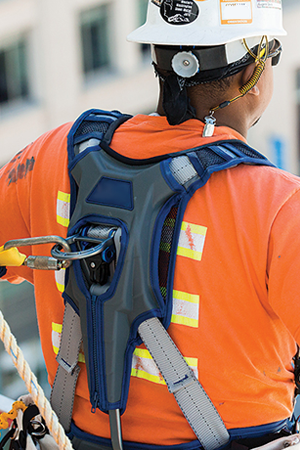Sometimes, working at height is unavoidable. And, if you’re working from a substantial height, the 3 points of contact rule is no longer enough to ensure the safety of you and your team.
If you’ve read about the different safety techniques when it comes to working at height, you’ll know that a safety harness is of paramount importance to ensuring you and your team are as protected as possible.
As falls while working at height count for 25% of fatal injuries at work each year, properly maintaining this equipment should be one of your top day to day priorities on site.
The key to properly maintaining your harness is understanding how to store, clean, inspect this vital piece of safety equipment.
While maintaining your safety harness may seem simple, ultimately there are a set of rules and regulations you should follow in order to guarantee the safety of your team. This is mainly through storing and cleaning:
When storing your harness, remember to H. O. C:
Your equipment should be cleaned on a regular basis. Not only will this help you guarantee there are no substances on the equipment that could degrade them, it will ensure that you can properly see each part of the equipment so you can do a thorough inspection.
Remember: Do not use any bleach, chlorine, or abrasives on your safety harness. This can damage the integrity of your PPE, putting you and your team at risk.
Properly maintaining your harness, however, should also include an inspection plan.

Like all PPE, in order to guarantee your harness is fit for purpose, all equipment must be checked before and after use to identify any areas of potential concern.
There are key signs of damage you should look out for, such as:
Regardless of the age of your harness, if it is damaged in any way from either improper storage or after an accident that has damaged the integrity of your safety equipment, it should be discarded.
Realistically, how long your safety harness lasts depends on:
Regardless of how often you use your PPE, the key to expanding its lifespan is by properly caring for them and regularly checking them. While you can do this onsite, we have found that our accredited 6-month checks can both help elongate the lifespan of less used harnesses that have passed the 5-6 year mark, as well as give an impartial view on the safety of your equipment.
In short, the best way to make sure your harness is fit for purpose is by storing it properly, having regular maintenance checks, and ensuring that you’re cleaning your equipment as necessary.
Ultimately, there is no definitive lifespan for safety equipment. While the 5-6 year lifespan is relevant for most harnesses, if you properly maintain your equipment and ensure it’s stored correctly, you may be able to use it longer than 5-6 years.
To do this, however, it is vital that you frequently carry out in-depth maintenance checks of your equipment to ensure that it’s fit for purpose and keeping you and your team safe at all times.
Get our expert knowledge delivered straight to your inbox, and keep up-to-date with the latest goings on in your industry.
Falls from a height continue to be the most common kind of fatal injury in the workplace for the 4th year running - with 171 fatal injuries from 2016-2021 being due to falls from a height. You may be ...
In 2005, the Work at Height Regulations (2005) were introduced to ensure the safety of those who work at potentially dangerous heights and they are still in place today. What does all this legal jargo...
According to HSE, you should be taking vital steps to protect your team when working at height. One way to minimise the likelihood of an accident is through the use of a Fall Arrest System.